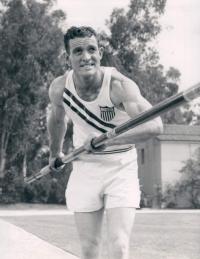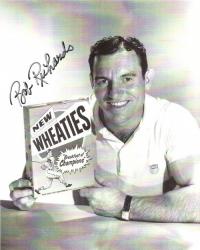
American pole vaulter Bob Richards, the “vaulting vicar,” set an Olympic record at 14 feet, 11 1/4 inches.

Champion vaulter Bob Richards promoting the “breakfast of champions.”

Al Oerta, at 20 years old, won the Gold medal in the discus throw, and dominated the event in the next three Olympics.
Editor’s note: As the 31st Games of the Olympiad approaches, August 5-21 in Rio de Janeiro, I thought it would be interesting to resurrect stories of former Olympics as written in Coconut Times in the summer of 1992, year of the Games in Barcelona, Spain.
In 1956, the people of Hungary were fighting a Russian invasion, but the Hungarian Olympic team, independently, still ventured to the 1956 Summer Olympics in Melbourne, Australia.
For the first time in Olympic history, the Olympic Games were celebrated in the Southern Hemisphere. It was also the first time that the games took place in November and December. This was Australia’s summer, not like the cold winter that we usually associate with these months.
There is another peculiarity about these summer games. The equestrian events took place in June at Stockholm, Sweden, due to severe quarantine laws. This was the first time the International Olympic Committee allowed an event to be separated from the main games.
1956 was also when France and Great Britain ventured into the Middle East. This resulted in the withdrawal of Egypt, Iraq and Lebanon from the Olympics. This was their protest to the Israeli invasion. The Netherlands, Spain, and Switzerland, protesting the Russian invasion in Hungary, also did not attend the 1956 Olympic Games.
For the first time in history, Ethiopia, Kenya and Malaya were represented at the Olympics.
The Australians welcomed all the represented nations to the Olympic Games. The opening ceremonies were held at the Melbourne Cricket ground. Norman Armitage, who had participated in every Olympics since 1932, now 49 years old, proudly carried the American flag. John Landy, an Australian who held the world record for the mile run, took the Olympic oath on behalf of the 3,500 athletes in attendance. 103,000 Australians filled the stadium. They continually packed the stadium to capacity for the track and field events.
The 1956 Olympics proved to be a year for all of the world’s athletes to shine. At the completion of these Olympic Games, the Russians had 37 Gold medals and 722 unofficial points. The Americans had 32 Gold medals and 593 unofficial points. It was this Olympics which gave the Soviet Union the title of the strongest athletic nation in the world.
Russia’s greatest hope was their long-distance champion, a Leningrad sailor, Vladimir Kuts. His event was the 10,000 meters. Kuts’ biggest rival was British Gordon Pirie.
In the race, Pirie was a fraction of a second behind Kuts. Kuts was passed by two Australians who cut him off and almost made him stumble. Kuts eventually regained his lead with a fantastic spurt to the finish.
There were a few events which proved to be a Russian-American rivalry. One event which was a direct competition was the hammer throw. The contest was between Harold Connolly, a New England school teacher, and Mikail Krivonosov, a Minsk school teacher. The two had been taking turns all year long breaking the world record.
Krivonosov was rated a slim favorite before the Olympics began. He took the lead in the second of the six rounds and held it until the fifth. Then Connolly made a throw six inches farther than the Russian’s best; this broke the Olympic record and won him the championship.
The Russian-American rivalry was also evident in weightlifting and boxing. In weightlifting, the United States won four Gold medals to the Soviet Union’s three. Russia got even in the boxing ring. Three Russians won championships, while only two Americans scored.
There were many stars to be found at the 1956 Olympic Games in Melbourne. American Charlie Dumas was the first man to high jump more than seven feet. Al Oerter, also an American, won the first of four successive Gold medals in the discus throw. Betty Cuthbert, an Australian, won both the 100- and 200-meter runs. She also was a member of Australia’s sprint relay Gold medal team. Brazil’s Adhemar Ferreira da Silva earned his second straight Olympic title in the triple jump.
American Bob Richards, the world’s best pole vaulter, on his third try in competition, cleared 13 feet and 1/2 inch. He later set an Olympic record at 14 feet and 11 and 1/4 inches. And who could forget America’s superstar, Bill Russell, from the University of San Francisco, who led the Olympic basketball team to a Gold medal.
The crew team from Yale won the eight-oared championship. In the first race, Australia and Canada both finished ahead of the Americans. Under Olympic rowing rules, Yale was allowed to compete in a repechage race for losers; and if they won, they could still enter the semi-finals. The team won the repechage race, as well as the semi-finals.
The Australian team conquered in swimming. John Henricks, John Devitt and Gary Chapman took first, second and third places, respectively, in the 100-meter freestyle. Australian Murray Rose won both the 400- and 1,500-meter freestyle.
American swimming wins came through Bill Yorzyk in the men’s butterfly and Shelley Mann in the women’s butterfly. America did win three of the four diving titles. Pat McCormick retained her wins in the springboard and highboard that she won at Helskinki in 1952.
In fencing, Gillian Sheen won the women’s individual title, Britain’s first Olympic fencing title. The men’s individual title was won by France’s Christian d’Oriola.
Overall, the Americans achieved success in track and field, the Australians in swimming, and Russians in shooting, wrestling and gymnastics.
The Summer Olympics at Melbourne proved to be very eventful. The competition was fierce, and the political upheavals throughout the world were just as fierce.
At the close of the Olympics, the events in Hungary and in the Middle East still lingered in the minds of many. The world seemed to be separated, but not the athletes at Melbourne. For the first time in Olympic history, the athletes did not march by nations, but rather, they marched informally. In the Olympic spirit of friendship, the athletes marched as friends of the world, not as warring nations. Russians with Englishmen, Frenchmen with Australians, Americans with Czechs, and Africans with Asians.
The Summer Olympic Games in Melbourne ended in 1956, many years ago, but the Olympic tradition continues today. We must remember the remarkable athletes of the past and continue to support the Olympiads of the present and of the future!
«Go back to the previous page.


